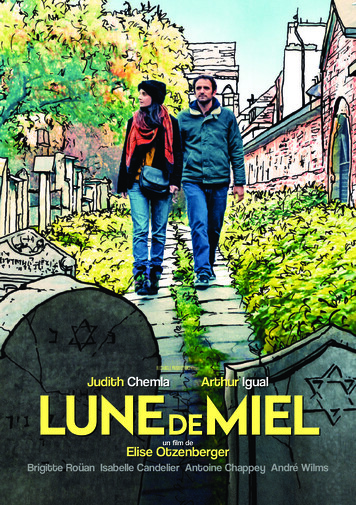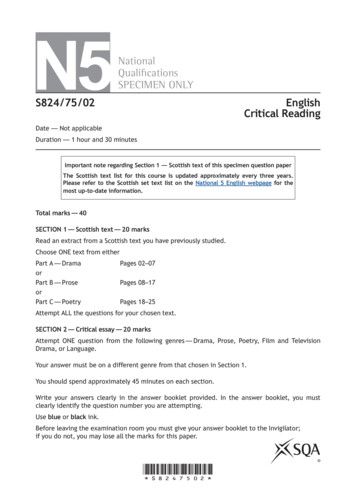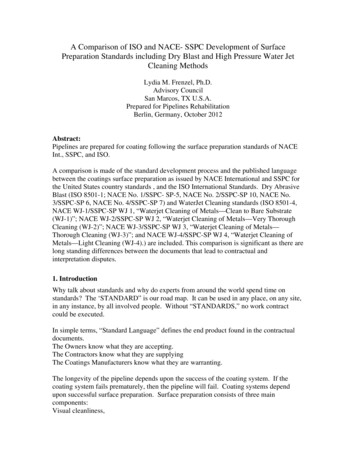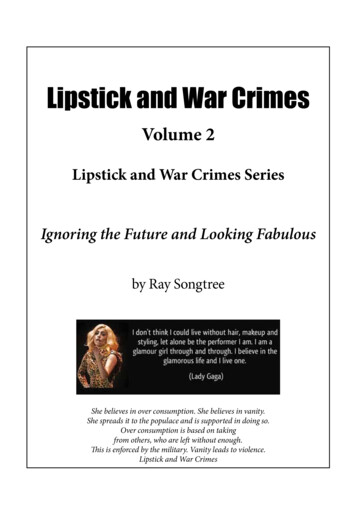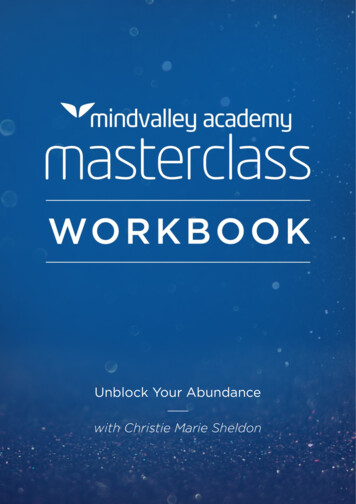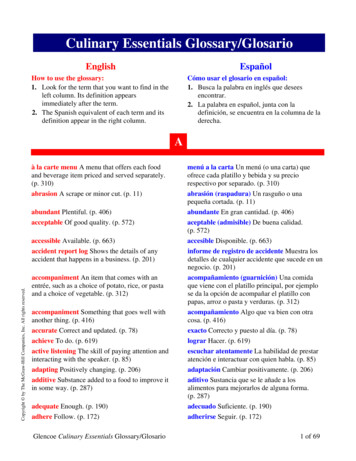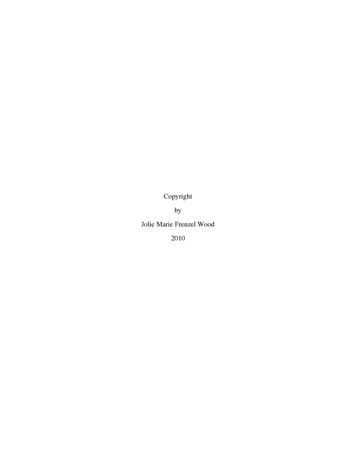
Transcription
CopyrightbyJolie Marie Frenzel Wood2010
The Dissertation Committee for Jolie Marie Frenzel Wood certifies that this is theapproved version of the following dissertation:White-collar Agitation, No-collar Compliance:The Privilege of Protest in Varanasi, IndiaCommittee:Clement Henry, SupervisorPhilip Oldenburg, Co-SupervisorItty AbrahamJohn HigleyRobert Moser
White-collar Agitation, No-collar Compliance:The Privilege of Protest in Varanasi, IndiabyJolie Marie Frenzel Wood, B.A.; M.A.DissertationPresented to the Faculty of the Graduate School ofThe University of Texas at Austinin Partial Fulfillmentof the Requirementsfor the Degree ofDoctor of PhilosophyThe University of Texas at AustinAugust 2010
AcknowledgementsFirst and foremost, I wish to acknowledge my adviser Philip Oldenburg, withoutwhose steady guidance and encouragement I probably could not have completed thisproject. I can only hope that this and future work justify even a small part of his effort onmy behalf. Clement Henry, Catherine Boone, and Itty Abraham have also beeninvaluable sources of intellectual guidance; the following pages show abundant evidenceof their influence. I am also deeply thankful to Ajay Pandey, whose assistance inVaranasi opened the city to me and made fieldwork one of the most rewardingexperiences of my life, and to Nitya Pandey, Vinay Sharma, and Dwarika Chaube fortheir research assistance during the summer of 2008. Finally, I am grateful for thegenerosity and frankness of all those in Varanasi and New Delhi who made this projectpossible—those who accommodated me, befriended me, advised me, shared their viewswith me, gave me their time, took a genuine interest in my research, and fueled me withinnumerable cups of tea and more.iv
White-collar Agitation, No-collar Compliance:The Privilege of Protest in Varanasi, IndiaJolie Marie Frenzel Wood, Ph.D.The University of Texas at Austin, 2010Supervisors: Clement Henry and Philip OldenburgAn investigation of contentious action by associations representing sixoccupational groups at different socio-economic levels reveals that middle-class groupstend to favor contentious means of making demands such as demonstrations and strikes,while lower-class groups tend to avoid contentious action, preferring moreinstitutionalized or contained means. While such findings might appear to be puzzlinggiven middle-class groups’ superior access to state institutions and the Habermasianconcept of a rational, orderly, bourgeois public sphere, they are consistent with theliterature on resource mobilization and social movements in the West: Access to financialresources and strong mobilizing structures enables the middle-class groups to takeadvantage of a political opportunity structure that rewards contentious action.v
Table of ContentsList of Tables . viiiList of Figures.ixChapter I: Introduction.1Introduction to Varanasi .4Introduction to the Occupational Groups Under Study.8Methods and Data.27Chapter Overview .33Chapter II: Theory.37The Public Sphere in Theory and in India.38Protest and Varanasi’s Public Sphere.48Findings: The Privilege of Protest.56Explaining the Findings: Resource Mobilization.71Alternative Explanations .83Class and Occupation .91Chapter III: Financial Resources, Mobilizing Structures, and Influential Allies .94Financial and Educational Resources.94Mobilizing Structures .104Influential Allies.119Preferred Means of Making Demands Upon the State.141Conclusion .147Chapter IV: Case Studies.149The Boatmen: Successful Strike with Outside Assistance .150The “Control Case” of Handloom Weavers versus Powerloom Weavers.159The Teachers: Routinized Contention.187The Lawyers: Familiarity Breeds Contempt? .194The Traders: Highly Politicized Contentiousness.208vi
The Doctors: A Special Case .226Chapter V: Conclusion .246Appendices .259Appendix A: List of Interviews .259Appendix B: Acronyms and Glossary.271Appendix C: Summaries of Questionnaire Data.275Bibliography .288Vita .300vii
List of TablesTable 1: Overview of Group Resources and Contentious Action. 35Table 2: Reports of Contentious Public Action by Occupational Associations in Varanasi,1998-2008 . 58Table 3: Contentious Action and Political Parties . 85Table 4: Types of Claims Made by Each Group and Levels of Contentious Action. 87Table 5: Contentious Actions by Weavers: Handloom Weavers vs. Powerloom Weaversand Strikes vs. Non-strikes, with Principal Mobilizing Structures. . 162Table 6: Survey Responses: To whom do handloom weavers go for help?. 164Table 7: Survey Responses: Is there any leader who works for handloom weavers?. 164Table 8: Survey Responses: Why aren’t handloom weavers organized?. 165Table 9: Doctors’ Attitudes Toward the IMA . 242viii
List of FiguresFigure 1: Location of Varanasi in India . 5Figure 2: A Continuum of Public Action . 61Figure 3: “Advocates on Hunger Strike.” Amar Ujaala, August 24, 2007, VaranasiEdition (page 6). 198Figure 4: Traders’ Reported Levels of Contentious Action in Dainik Jaagran, 19982008 . 222Figure 5: Trend in Reports of Contentious Actions by Doctors (Dainik Jaagran, 19982008) . 239Figure 6: Illustrating the Hypothesis of Curvilinearity: Number of Contentious Actionsand General Levels of Resources in Varanasi . 248ix
Chapter I: IntroductionIn popular consciousness, protesters are those who have been excluded from thebenefits of society, who want to change the political system, who are “mad as hell” andnot going to take it anymore. What does it mean, then, when we find that it is not theexcluded or deprived who engage most frequently in protest, but the privileged, educatedmiddle classes, those who are more capable of accessing institutions of the state?In the United States, the early scholarly work on social movements was based onthe assumption that protest was driven by grievances, the result of structural conditionsthat lead to the deprivation and frustration of a particular group, combined with thespread of a belief system regarding the causes of their grievances and the best means ofredress—in other words, an ideological justification for agitation (Zald and McCarthy,1987: 150). However, no relationship between deprivation and the occurrence of socialmovements could be established; grievances were ubiquitous throughout time and space,while protest was not. Furthermore, Mancur Olson’s elucidation of the collective actionproblem presented the puzzle of why anyone would join a movement if he or she couldreap the benefits without the paying the cost (1965). From Olson’s insight emerged anew emphasis upon the costs and benefits of participation in social movements, theimportance of organizational bases, and participants’ expectations of success.Thisapproach became known as “resource mobilization theory” (RMT) and inspired aprofusion of new studies on social movements. Of course, RMT presented its ownpuzzle: How are some groups that lack resources still capable of mobilization? Scholarsthen turned their attention to political processes and opportunities for richer explanationsof why social movements occurred, particularly among excluded or resource-poorgroups. Prominent scholars such as Charles Tilly, Sidney Tarrow, and Doug McAdam1
led this field of inquiry, and the resource mobilization approach eventually declined ininfluence.In Varanasi, India, we find a puzzle of a different sort.The political andinstitutional environment effectively encourages contentious action, but some groupsprotest far more than others. There is a lively public sphere of rational critical discoursethat is far more diverse, politicized, and contentious than the formalized bourgeois realmthat Habermas describes in 18th century England. Groups of all kinds, representing awide range of economic and political interests, battle for public and state attention.Protest is quite frequent, as is evident from the reports that appear in the newspapersalmost daily.Furthermore, the state effectively encourages contentious action byresponding to protestors’ demands in a speedier manner than they probably would if theprotestors followed normal procedural channels.However, not all groups respond alike to this institutional environment. Middleclass groups resort to contentious action far more often than lower-class groups.Therefore, while a consideration of structural, environmental or institutional factors canoffer much insight into the overall incentives to protest, the resources of each groupstrongly influence the extent to which it can take advantage of this uniquely effectivemeans of making demands. Building and sustaining strong, well-organized mobilizingstructures; taking the time to organize and participate in contentious actions such rallies,processions, sit-ins, and especially (most importantly) strikes; accepting the risk of bodilyharm or arrest by the police; and potentially losing income as a result of participating inprotest all require a certain level of financial resources and security that differentoccupational groups posess in sharply varying degrees. In Varanasi, and probably morewidely in India, protest is a privilege.2
This study examines the means by which associations representing sixoccupational groups (boatmen, weavers, teachers, lawyers, traders, and doctors) makedemands upon the state. A year and a half of fieldwork involving 157 interviews inHindi and English, extensive direct observation, a survey of eleven years’ worth of newsreports in a local Hindi daily, and informal questionnaires conducted among the membersof each occupation yielded strong evidence that the middle-class occupational groups(traders, lawyers, and teachers) carried out far more protests and strikes than the lowerclass groups (boatmen and weavers). Impressions gained during interviews and directobservation were mostly confirmed by the survey of news reports of contentious actions.However, reports of irregular levels of contentious action by the one upper-middle-classgroup, the doctors, showed that there is not a strictly linear, positive correlation betweenresources and a tendency toward contentious action. The doctors had perhaps the highestlevel of resources in terms of both personal financial resources and the strength andwealth of their primary association. This suggests that the relationship between resourcesand contentious action may be curvilinear, which implies that the resource mobilizationapproach may require further refinement or modification. On the other hand, such afinding might also be due other factors that militate against protest and that are peculiarto this particular occupation.This study represents one of the few attempts (or perhaps the first) to applyresource mobilization theory to contentious action in India. It also breaks new ground interms of the kinds of contentious action to which it is applied.Traditionally, theapproach has been used mainly with regard to large social movements, however thisstudy shows that resources are just as relevant in explaining variations in levels ofroutine, every-day demand-making.3
The following pages provide an introduction to the city of Varanasi and to each ofthe six occupational groups. Then the methods used in collecting the data for this studywill be discussed in further detail. An overview of the remaining chapters concludes thisintroduction.INTRODUCTION TO VARANASIWith a 2010 estimated population of just over 1.2 million people, Varanasi, alsoknown as Banaras and Kashi, is the principal city in eastern Uttar Pradesh, itself the mostpopulous state in India. It is the administrative seat of Varanasi District, which has apopulation of over three million (Census of India 2001). Its large district court complexdraws thousands of people from surrounding villages and small towns every day.Located on the Ganges River, the city has been a center of commerce since at least thelate 1700s, as it occupied an important position between Bengal in the east and theMaratha territories in the west. With over 26% of its workforce now engaged in retailtrade, it remains the primary commercial hub of eastern Uttar Pradesh and Bihar state(Census of India: 2001; Bayly, 1983: 104-106; Freitag, 1989: 1-22). The other majorindustries, in terms of their numbers of workers, are “business activities” (10%), publicadministration (9%), textile manufacturing (9%), and education (6%) (Census of India2001). It is also the site of Banaras Hindu University, one of India’s largest universities,the founding of which was an important moment in the nationalist movement of the earlytwentieth century (Renold, 2005).4
Figure 1:Location of Varanasi in IndiaVaranasi is regarded as one of the oldest living cities in the world, with evidenceindicating continuous habitation for at least the past three thousand years. As MarkTwain famously noted, “Benares is older than history, older than tradition, older eventhan legend, and looks twice as old as all of them put together” (1897: 480). It has longbeen a cultural and religious center, having been the home of poets and writers such asKabir, Tulsidas, Ravidas, and Premchand, and musicians such as Ravi Shankar andBismillah Khan. In Hindu tradition the city is associated with Lord Shiva and is theholiest of Hinduism’s seven holy cities; as such it is one of the most important pilgrimagedestinations in India. It is also regarded as a sacred city by Buddhists and Jains: TheBuddha delivered his first sermon in nearby Sarnath and established his first teaching5
circle among fellow monks there, while an important Jain teacher, Parshvanatha, wasborn in the city. While Varanasi is popularly regarded as having a strongly Hinduidentity, its historically large Muslim population, currently about 27 percent of the totalpopulation, has also had an important influence on local history and culture, particularlypoetry and music, and dominates the city’s famous silk weaving industry.While India still has a primarily rural population, it is becoming more urban andscholars are increasingly shifting their attention to urban areas. A UN Habitat reportestimated India’s urban population at 27.7% of the total population in 2000 and projectedthat this figure would rise to 41.4% by 2030 (United Nations Human SettlementsProgramme, 2005: 4). However, most scholarly attention to urban areas in India has thusfar been devoted to the big cities of Mumbai, Delhi, and Kolkata. The mid-size citieshave largely been neglected, despite the fact that most of the large urban agglomerationsin India have populations of between one million and two million people (Brinkhoff,2010). Therefore, a mid-size city was desired as the subject of research as it wasconsidered in a way more “representative” than the mega-cities.Varanasi was chosen as the site of this study because of its position as asignificant urban center in the North Indian “Hindi Belt.” It was necessary to choose acity in which Hindi (or a variant thereof) was the primary language, so that the authorcould communicate with people. Varanasi’s status as a holy city might make it appeartoo special to be taken as representative of mid-size North Indian cities. Its holinessamong Hindus certainly has had some political ramifications. For one, its population hasan unusually high proportion of Brahmins, and due partly to this and partly to the strongreligious and traditionalist sentiment of many other Hindus in the city, there is widesupport for the right-of-center Bharatiya Janata Party, a party strongly associated withHindu nationalism and religious conservatism and that has otherwise not been doing6
terribly well in Uttar Pradesh in recent elections. However, the city’s religiosity did notappear to have any discernible influence on the practical and economic concerns of theoccupational associations under study, or on how they promoted these concerns.Occupational associations in Varanasi are focused on the same bread-and-butter issues asthose in any other city. In the course of researching the ways these groups protect theeconomic and personal interests of their members, Varanasi’s status as a commercial andadministrative center was far more evident and significant than its role as a pilgrimagesite. Banarsi Hindus’ religiosity clearly does not get in the way of their mundane pursuitof economic security. For example, when the right-wing Hindu nationalist movement todestroy mosques built upon the sites of temples destroyed during the Mughal era seemedto threaten Varanasi’s Gyanvapi Masjid (having achieved “success” with the demolitionof Ayodhya’s Babri Masjid in 1992), the city’s residents, led by the primarily Hindushopkeepers located around the mosque, resisted this threat to local peace and prosperity.Without local support, the movement ran aground in Varanasi.1A scholar studying a different subject (e.g., local social and religious rituals)might have a different perspective, as she would have been immersed in a different areaof local life. This researcher, however, conducted research in the city for a year and ahalf and found that Varanasi’s religiosity had only the most peripheral relationship to thesubject of investigation. Therefore, it is maintained that Varanasi is no more or less“representative” of mid-size North Indian cities than any other, “representativeness”being an elusive goal in qualitative social science research.Every city of roughlycomparable size is “special” in some way: Kanpur as an industrial center, Agra and1Personal interview, Dipak Malik, Gandhian Institute of Studies, 6 August 2006 (Varanasi); Personalinterview, J. P. Upadhayay, President, Vishwanath Gali Vyavsai Sangh (Vishwanath Gali BusinessAssociation), 10 February 2007 (Varanasi); Personal interview, Mr. Shankar Giri, General Secretary,Vishwanath Gali Vyavsai Sangh, and Vice President, Mahanagar Bharatiya Janata Party, 27 February 2007(Varanasi).7
Jaipur as tourist attractions, Lucknow as a state capital and center of Mughal courtlyculture, Patna as the capital of India’s most “backward” state, Bihar. Varanasi is indeedspecial and, at the same time, entirely typical in its specialness.INTRODUCTION TO THE OCCUPATIONAL GROUPS UNDER STUDYIn this section, each of the six occupational groups is introduced in terms theoccupation’s economic, historical, and social significance in Varanasi or more broadly inIndia, the caste and religious identities of its members (some of the occupational groupsare more diverse than others), and major occupational concerns or problems.BoatmenAs one of the holiest cities in India, Varanasi is a major pilgrimage destination fordevout Hindus as well as a popular tourist attraction for Indians and foreigners alike. It islocated on the banks of the Ganges River, where approximately two thousand boatmenply their trade, taking pilgrims and tourists out onto the river for religious rituals andsightseeing.The boatmen of Varanasi have long been integral to the economic, social,cultural, and religious life of the city. They constitute both an occupational group and a“caste” (or more precisely, a cluster of groups or jati that traditionally have made theirliving by boating, fishing, diving, and other means associated with the river). Theirgeneral caste designation is Mallah, classified by the Government of India as a MostBackward Caste (MBC), one administrative notch above Scheduled Caste, as the dalit oruntouchables are classified. However, these two identities do not overlap perfectly:“[W]hile all boatmen belong to the Mallah caste (jati), not all Mallahs are boatmen. In8
fact, the majority of all Mallahs in Banaras are engaged in occupations not connected tothe river economy” (Doron 2008, 16).The boatmen’s work includes taking passengers on rides and ferrying people fromone part of the river to another, building and repairing their boats, engaging insupplementary but related work like fishing, diving, and (in recent decades but nowdecreasingly) sand-mining. Despite their important social functions, the boatmen arealmost entirely lower class, with a few successful ones breaking into the middle class byacquiring fleets of boats and hiring others to ply them. Most boatmen either row theirown boat or a boat belonging to another and take home what they earn each day.Doron discusses the Mallahs’ efforts to raise their position within the Hindu socialhierarchy and create a more unified “imagined community” by adopting the nameNishaad for their community, a name considered more “auspicious” and “dignified”(2009, 8).In interviews by both Doron and this author, many Mallah leaders andactivists extolled their “mythic ancestry” (Doron 2009, 16) by citing scenes from theRamayana in which the Mallah/Nishaad community protects and accompanies Lord Ramduring his exile, particularly the scene in which a boatman ferries Ram, his wife Sita, andhis brother Lakshman across the Ganges River.2 Further efforts at raising the status ofthe community include a narrative that cites the contributions of the Mallahs to theIndependence Movement, connecting their efforts to the larger project of Indian nationbuilding (Doron 2009, 9).In what might appear a paradox, the Mallahs of Uttar Pradesh are also slowlyincreasing pressure upon the government to be classified as a Scheduled Caste, the formal2See Doron 2009, 16. Also: Personal interview, Radhey Mohan Bind (aka Radhey Mohan Saral), boatmanleader and Bahujan Samaj Party worker, Trilochan Ghat, 21 October 2007 (Varanasi); Personal interview,Sheobodh Ram, District In-Charge, Bahujan Samaj Party, 25 October 2007 (Varanasi); Personal interview,Vinod Kumar Nishaad, activist, Rajendra Prasad Ghat, 5 June 2008 (Varanasi); Personal interview,Dayashankar Mishra, Congress Party leader, 8 June 2008 (Varanasi); etc.9
administrative designation for those communities previously known as “untouchable.”3This official diminishment of status would make available to the community considerablestate benefits, including a reserved quota of public sector jobs, a number of reserved seatsin the Lok Sabha (Parliament), and reserved slots in institutions of higher educationfunded by the central government (comparable to the concept of affirmative action in theUnited States).Doron lends some insight into how this might not actually be asparadoxical as it appears: He suggests that the Mallah activists’ assertions of anhonorable history combined with the oppression and poverty of their more recent pastyields a “heightened sense of entitlement,” which they are turning into demands for statecompensation (Doron 2009, 20).Aside from these broader issues, there are several long-standing issues of concernto the boatmen of Varanasi. It is these more immediate, local matters that have providedthe main impetus for their mobilization, when it happens, and form the substance of theirinteraction with local administrative authorities and the state government in the past fewyears. Foremost have been the bans on fishing and the use of motorboats on the riverwithin the city. In the interest of reducing the contamination in the Ganges River causedby the immersion of human remains during funeral rituals, the Uttar Pradesh ForestDepartment in 1989 began introducing a species of turtle that feeds off of decayingflesh.4 In order to encourage the propagation of this turtle species, the state government3Personal interview, Baburam Nishaad, prominent community member, 13 October 2007 (Varanasi);Personal interview, Prithvi Majhi and Gopal Majhi, community leaders and activists, 19 October 2007(Varanasi); Sujit Kumar Nishaad, General Secretary, Uttar Pradesh Nav Yuvak Maajhii Samaaj Samiti, 5June 2008 (Varanasi); Personal interview, Dayashankar Mishra, Congress Party leader, 8 June 2008(Varanasi); Etc.4 Varanasi being considered an auspicious place to die, where one can finally be released from the cycle ofbirth and death (attain moksha), many cremations are carried out daily on the banks of the Ganges River.According to a traditional cremation ritual, when a body is cremated, a small part of it is reserved andoffered to the river. The bodies of some are not cremated at all, i.e., the bodies of holy men or sadhus,children, animals, and those who die of snake bites (the last, as it was traditionally believed, having thepotential to return to life). The sheer volume of such immersions has caused a level of contamination thatis now widely (though not universally) regarded as a public health threat (many traditional Hindus continue10
designated the entire length of the river passing through the city as a wildlife sanctuary.As in all wildlife sanctuaries, then, all fishing and boating is technically banned (officialsenforce the ban only with regard to motorboats, not rowboats), which directly affects theboatmen’s livelihoods. Other major issues include state and municipal taxes for carryingpassengers and boat registration fees, as will be discussed in the case study below;boating restrictions during the monsoon season; government employment and fairremuneration for divers who assist the police in retrieving the bodies of the drowned aftera boating accident or overturning; and the allocation of government contracts for sandmining, a traditional occupation of the Mallahs. Members of the Yadav community aresaid to have recently taken over the sand-mining business and now receive almost allgovernment contracts for this work.5One surprising finding was that despite the large population of Mallahs in the city,estimated at 50,000, the boatmen do not have any stable, strong links to any singlepolitical party. One might expect that in an electoral system widely characterized as apatronage democracy based on clientelistic relationships between parties and caste andreligious groups (e.g., Chandra 2004), such a large community in a city of one millionwould carry considerable political clout.However, the boatman community is notto believe that the Ganges purifies whatever it touches, and even some biologists believe that the river’secosystem naturally processes much of the contamination). Personal interview, Chhote Lal Nishaad,General Secretary, Mallah Samudaay Sangharsh Samiti, 18 March 2007 (Varanasi); Personal interview,Subhash C. Tripathi and Ram Avatar Singh, Uttar Pradesh Aranya/Van Vibhag (Uttar Pradesh ForestDepartment), Varanasi District, 31 October 2007 (Ramnagar); Interview, Bhaiyya Lal Nishaad and SujitKumar Nishaad, Uttar Pradesh Nav Yuvak Maajhi Samaaj Samiti (New Youth Maajhi Samaaj Samiti), 18March 2007 (Varanasi); Etc.5 Several statements during informal conversations hinted at some competition or low-level animositybetween Mallahs and the more prosperous and powerful Yadav community, traditionally associated withherding and the production of dairy products, and currently classified as a backward caste (OBC). Personalinterview, Dayashankar Mishra, Congress Party leader, 6 June 2007 (Varanasi); Personal interview,Radhey Mohan Bind (aka Radhey Mohan Saral), BSP w
population of over three million (Census of India 2001). Its large district court complex draws thousands of people from surrounding villages and small towns every day. Located on the Ganges River,

